Refurbishing an existing building rather than building new is the climate friendly option now favoured by many in the industry. If demolition firms want to stay in business, they need to clean up their act fast – and some are doing just that, writes Tom Lowe
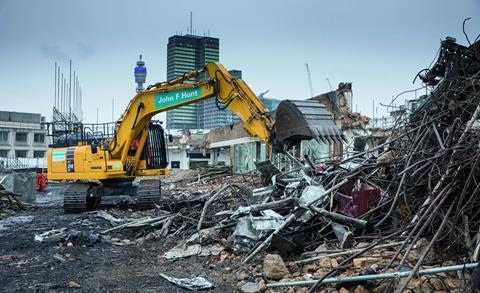
“Demolition gets bashed for all sorts of reasons. It’s loud, it’s dusty, it’s noisy.” So says Ben Griffiths, operations director at demolition contractor Rye. “The perception that demolition is unsustainable is just the next thing that we’re going to get bashed with – and I think there is a good argument to counter it.”
Few in the built environment are defending demolition at the moment. As the industry searches for ways to reduce its carbon emissions – 40% of the UK’s total – the consensus among climate experts has been that knocking down a building and starting again from scratch is just about the least sustainable approach to construction possible. But some are now launching a fight back.
Rye is among a group of demolition contractors which are making concerted efforts to become greener. Measures include switching to less carbon intensive fuels for on-site machinery and finding new ways to reuse materials from demolished buildings.
“There’s a lot going on in the background that is not really in the public sphere,” Griffiths says. “We can help people understand that demolition is actually pretty bloody sustainable.”
The prospect of solving all of the problems associated with demolition would bring a collective sigh of relief from everyone working in the built environment, and especially from architects. While the virtues of preserving heritage buildings are widely accepted, the relatively new taboo of tearing down less valued structures is an inconvenience to most practices.
Few architects, if they are really being honest, would contest that designing a shiny new vision for a site is more creatively exciting than refurbishing an existing building. Having an opportunity to have that kind of impact on a neighbourhood is often the reason why many enter the profession in the first place. And nothing stamps a practice’s brand more clearly on the sector than the triumphant opening of a big-statement, attention-grabbing new-build.
But the days when a developer could breezily flatten a perfectly functional, if aesthetically outdated, building and replace it without some kind of industry backlash appear to be coming to an end. Nowhere is this more clearly illustrated than with the proposed demolition of Marks & Spencer’s flagship store on Oxford Street, which was blocked by former communities secretary Michael Gove in June. The Pilbrow & Partners-designed plans would see the 1930s building replaced by a 10-storey office and retail block if a public inquiry next month decides in its favour.

The case has become something of a cause célèbre for green activists and heritage campaigners alike, with big names from across the built environment and within government calling for the scheme to be scrapped. Steve Tompkins, managing director of Stirling Prize-winning practice Haworth Tompkins, has said that the existing building could easily be retrofitted instead of replaced and argued that refurbishment projects should play a “far more central role if we are serious about addressing the planetary emergency”.
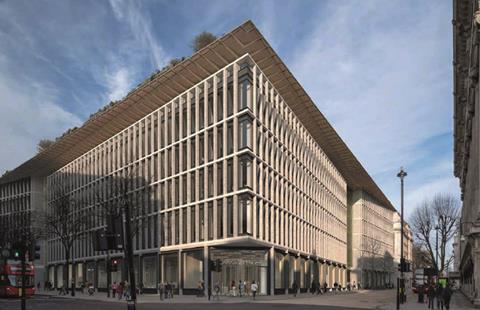
Conservative MP Duncan Baker, who was the original backer of the Embodied Carbon Bill launched earlier this year which would limit embodied carbon in projects, said rethinking these types of demolitions was vital if the UK wants to achieve its net zero objectives. And Nicholas Boys Smith, the government’s housing design tsar, said the row over the scheme goes “right to the heart” of discussions about sustainability. Calls for the building to be saved have even been joined by Notes from a Small Island author Bill Bryson, who said that he was motivated by a wish to “stop a bit of foolishness”.
Even if the public inquiry clears the way for M&S’s plans, the furore that has erupted speaks volumes about where the industry is currently at on demolition. The die, to all intents and purposes, has already been cast.
While a new building can be made to be more operationally energy efficient than an older one, refurbishment can also bring an existing structure up to the same standards. And the embodied carbon emitted during demolition and the manufacture of an entire building’s worth of new materials, and then during construction, is always likely to be vastly greater than what is emitted by a retrofit.
The perception demolition is unsustainable is just the next thing that we’re going to get bashed with
Ben Griffiths, operations director, Rye
So, when the UK’s biggest practices are busy signing themselves up to emissions reduction targets and backing climate campaigns, including the Part Z initiative which formed the basis of the Embodied Carbon Bill, what does that mean for the future of architecture? The logical conclusion is that our townscapes will be frozen in time, with new schemes limited to energy efficiency upgrades to existing properties and the occasional extension. That might be the right thing to do, but it is not a particularly exciting prospect.
It would also have a major impact on demolition firms, and the threat posed by the move towards greater sustainability has not gone unnoticed in the sector. Net zero is “on everybody’s agenda,” says Howard Button, chief executive of the National Federation of Demolition Contractors (NFDC).
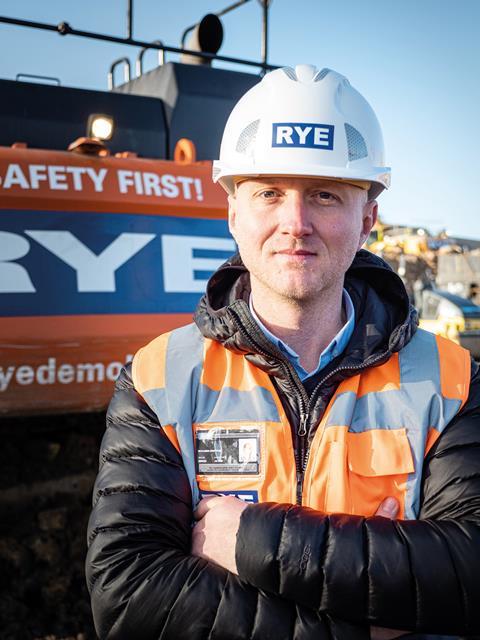
“All of our members now are very aware of the environmental and social benefits. We’ve signed up to net zero and construction pledges; we’re trying to encourage members to go that way,” he says.
The NFDC is also pushing its members to use hydrotreated vegetable oil (HVO), a fuel which suppliers say can reduce the carbon emitted from on-site plant by as much as 90%. HVO can be used in almost all normal diesel engines without any need for modifications, although it is more expensive than traditional fuels.
Rye, which has switched its entire fleet to HVO, is one of the demolition firms leading the way. The firm signed a 12-month fixed contract with supplier New Era Fuels for a type of HVO called Green D+, which is mixed with an additive that chemically reduces nitrogen oxide, a pollutant, while oxidising combustion gases. Rye director Simon Barlow then introduced New Era Fuels to the NFDC, and the supplier made a presentation at the trade body’s 80th-anniversary event in October last year.
“The uptake was huge,” New Era Fuels managing director James Hunt says. Many demolition contractors, including Cawarden, John F Hunt, Toureen and Howard Stott Demolition, signed 12-month contracts, and sales of the fuel increased to two million litres.
All of our members now are very aware of the environmental and social benefits. We’ve signed up to net zero and construction pledges; We’re trying to encourage members to go that way
Howard Button, chief executive, National Federation of Demolition Contractors
Sales of the fuel when it was launched in 2019 were around 50,000 litres, and the firm has now supplied more than four million litres to its customers. Hunt says sales to demolition contractors equates to more than 5.75 million tonnes of carbon emission reductions.
Griffiths remembers it differently. “There was a lot of scepticism in the room,” the Rye operations director says. “People in demolition, I find, are very difficult to change.” But he says switching to the fuel has been “one of the easiest wins we’ve ever had” and promoting the change has won the firm a lot of work with new clients.
It is the clients, and the green financing deals that underpin many schemes, which will ultimately make demolition greener. “We’re not forcing you to use HVO but I think your clients will,” Button had told NFDC members.
“If you want to work for a big developer, they will insist you use HVO on their sites to meet their climate commitments. I can see it coming. It’s logical that it will go that way,” he says.

But reducing carbon emissions from site operations is just a small part of the process of making demolition sustainable. The main carbon cost of demolish-and-rebuild projects is the huge amounts of embodied carbon emitted during the production, transportation and installation of new materials required in the replacement building. Although around 95% of materials from a demolished building are typically recycled, the carbon cost of shipping components such as steel overseas – usually to China – to be melted down and reprocessed is often high. Only by reusing materials from the original structure can these schemes have any hope of approaching net zero emissions.
This is the main challenge for developers. Currently, only around 1% of materials in north-west Europe are reused following their first application, according to figures from the FCRBE, an EU project aiming to increase material reuse. The same figure is quoted by both the NFDC and Rye.
“It’s very difficult,” Griffiths says, partly because of regulatory difficulties in certifying reused materials and partly because of the effort required to safely remove them from a building.
“A lot of clients go through the exercise with us because they have to,” he says. “It’s a BREEAM box tick. You do an audit for materials, give it to the client and they make the decision on what is viable to be reused. If I’m honest, quite often with steel it appears more hassle than it’s worth to reuse because of the requirements.”
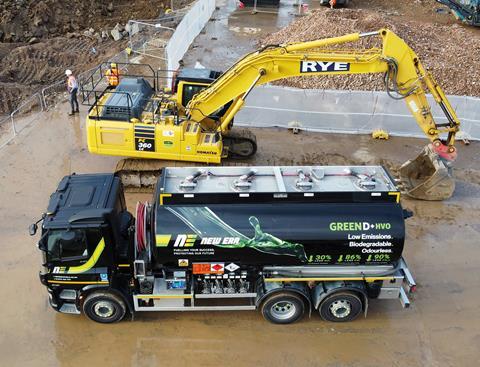
Modern composite materials used in many projects built with modern methods of construction (MMC) are not helping. Prefabricated components that are glued together offsite are “nowhere near as recoverable” as traditional materials, Button says, because they are almost impossible to separate and return to source materials.
He gives the example of an MMC student accommodation block at Birmingham City University which was flattened by demolition firm DSM in 2020. DSM managing director Robin Powell says that “virtually nothing” from the block could be reused, and the volume of material which could be recycled dropped by 30% compared with a traditionally built structure.
He says that builders “don’t think about demolition at all” when designing and constructing buildings. “I find time and time again that for people designing both the components and the complete building, the last thing on their minds is recycling and reuse of the component parts.”
The block’s walls consisted of layers of plasterboard, insulation board and fire-resistant fabric which could not be separated. “With a bit of thought and with a bit of care, all of those components could be reused,” Powell says. “In practice it could make everything more efficient for the future.”
>> Also read: The Elefante in the room
>> Also read: Mandatory plans to cut carbon in projects put back on the table
Addressing this could require a major rethink of MMC approaches such as volumetric modular construction which use prefabricated materials. The irony is that MMC is often championed as essential to reaching net zero by the same industry climate groups, such as the UK Green Building Council, which call for greater reuse of materials.
Rachel Hoolahan, architect and sustainability co-ordinator at Shoreditch practice Orms, says designers who specify composite materials “just haven’t considered” their viability for reuse. “They’re just trying to do their job of making the best possible building for their clients, but I think sometimes they don’t realise the true impact of it,” she says.
“A very easy thing to fall into is you could think you’re doing the right thing by gluing materials together, but actually inadvertently just sticking it all so much together that we can’t possibly take it apart.”
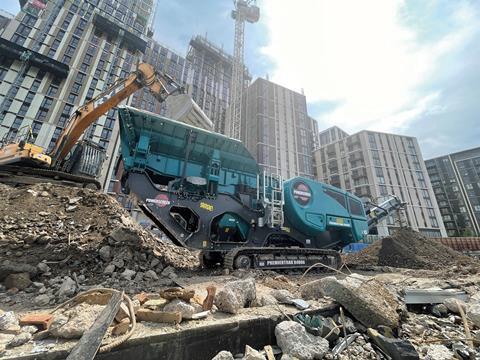
But she says there has been a lot more conversation recently about ensuring materials can be disassembled at the end of a building’s lifetime, and the industry has started to take the issue more seriously. “I think MMC and prefabrication is all brilliant,” she says. “The challenge for the industry at the moment is: how do we balance both sides of the equation? How do we take the good parts from MMC and avoid the bad parts?”
One example of material reuse being considered at design stage in an MMC scheme is Blackrock Street in Manchester, a 22-home social housing development completed in September last year. Designed by Eco-Res Architecture, it used individual components within a timber-frame system which can be separated at the end of the building’s life.
The client, housing association One Manchester, had asked for the scheme to be net zero in terms of operational carbon, but had been persuaded by Eco-Res to “go a bit further and look at embodied energy as well”, the practice’s director John Wybor says.
Avoiding the use of composite materials was easy, he says. “It’s just a matter of choice. It’s the importance of making the right decisions at the early design stage.”
The scheme has also been designed for adaptability. None of the internal walls are load-bearing, so they can be reconfigured over time depending on occupant needs decades into the future. It means that a future developer would be less likely to have to tear down the building if they want a different use from the site.
But thinking about a building’s end of life is “in its infancy”, Wybor says, adding: “It should be thought of now, and it should be accommodated in design, and there’s no reason why it can’t be.”
There is also the possibility that a scheme which can be adapted or which contains easily reused materials will have a future commercial value, especially if policy-makers decide to remove the much-criticised 20% VAT rate on refurbishments, or if other financial incentives are offered for low carbon demolish-and-rebuild projects.
Ten years ago, industry experts might have said that composite materials were the future of construction and that designers should move away from traditional building methods. Now it seems that the way forwards might be the way backwards. As much as 30% of a typical Victorian house could be reused, according to Button. Demolition can be made significantly greener, but to achieve that will require systemic changes to how buildings are designed and how materials are produced.
As for the demolition sector, its survival instinct is kicking in. Rye is currently looking at ways to reuse glass, which is normally crunched up by a machine on site. The firm has also carried out its first annual carbon audit and is identifying ways to further reduce emissions.
The Embodied Carbon Bill, if it secures the support of the government, would put much greater pressure on the built environment to think about alternatives to demolition. But, if the right choices are made, they might not have to think too hard.



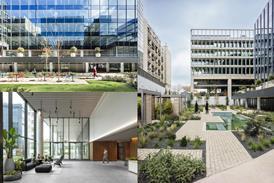







![2 & 3 Angel Square - Angel Square Public Realm NOMA - View 04 - 2022 Issue06[1] (2)](https://d3rcx32iafnn0o.cloudfront.net/Pictures/100x67/3/4/8/1934348_23angelsquareangelsquarepublicrealmnomaview042022issue0612_589011.jpg)



No comments yet